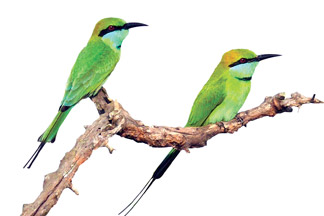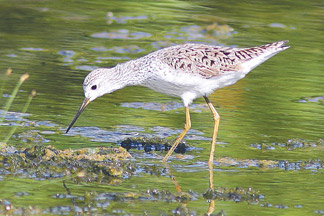|
World Migratory Bird Day :
Ruffled feathers
Sajitha Prematunge

Colombo University Zoology Department Head
Prof Sarath Kotagama. Picture by Nissanka Wijerathne |
 |
| National Bird Ringing
Programme conducted by the Field Ornithology Group of Sri
Lanka (FOGSL) headed by Prof Sarath Kotagama . Bird ringing
or bird banding is a technique used in the study of wild
birds, by attaching a small, individually numbered, metal or
plastic tag to their legs or wings, so that various aspects
of the bird’s life can be studied by the ability to re-find
the same individual later. |
The World Migratory Bird Day is
organized by the African-Eurasian Migratory Waterbird Agreement (AEWA)
and the Convention on Migratory Species (CMS). Its theme focuses on
how land use patterns affect bird migrations. Although these
transformations are essential for the survival of the human race,
they have quite literally, ruffled a few feathers
 |

Black tailed Godwit, known to fly up to
4000 kilometres at a stretch |

Marsh Sandpiper

Flamingos at Bundala |
There is no doubt that land use patterns continue to affect many a
feathered friend. The theme of the World Migratory Bird Day (May 9 - 10)
this year is how land use patterns such as urbanization, land
reclamation and intensive agriculture, affect bird migrations. Although
these transformations are essential for the survival of the human race,
they have quite literally, ruffled a few feathers.
Every year migratory birds such as Geese, Thrush, Terns and Godwits
fly thousands of miles to wait out the winter. Black tailed Godwit are
known to fly up to 4000 kilometres at a stretch. “Migration is not a
simple movement.” explained Colombo University Zoology Department Head
Prof Sarath Kotagama.
He explained that bird migration is a by-directional movement, which
takes them from their breeding to roosting grounds in the tropics and
then back again. “Their paths are very clearly defined.” Prof Kotagama
said that their ‘site tenacity’ is a factor that makes this phenomenon
unique. Year after year they return to this same location. “It is a
genetically built-in mechanism, rather than behavioural, as previously
believed.”
Master navigators
Studies on general migration indicate that the birds could be using
stars as celestial maps. “Some believe they use geomagnetic fields,” he
explained. “Or they maybe going by geographic features,” such as the
coastlines, rivers, vegetation patterns. Yet others believe that the
birds make use of infrared light, using the position of the sun as a
point of reference. As much as 47 percent avifauna in Sri Lanka, some
120 species, are migrants. Hundred percent of waders in Sri Lanka,
except sub species of Kentish Plover and Little ringed Plover, that
breed in Sri Lanka, make water edges their temporary home. Ninety five
percent of ducks, 60 percent of birds of prey in Sri Lanka, such as
Harriers and Buzzard, are also migrants. Sandpipers, Golden plover,
Redshank and Curlews are among the common migrants.
“Terns and almost all gulls of the shore bird group are migrants. But
the migrant forest bird group comprising Indian Pitta, Brown shrike and
a number of Warblers, is comparatively small. Those who can be found in
the hill country include Kashmir Flycatcher and Pied Thrush. Indian Blue
Chat is one of a small group of migrant ground birds.
Major migrant destination
The reason that Sri Lanka is a major migrant destination is that
there is no other land mass south of the island, making the island a
much sought after feeding ground for spring breeding winter migrants,
explained Prof Kotagama.
They come only for feeding and go back for breeding, which is why
they are referred to as migrants. However according to anecdotal
evidence a certain bird group has chosen to stay behind and breed.
“There is a breeding population of Blue tailed bee-eaters around the
Kumana Santuary and Udupotthana in Yala Block 2.”
But this does not disqualify Blue tailed bee-eaters as migrants;
apparently it is only a small group.
The birds start migrating southward because of the food scarcity in
August that precedes winter. By mid April they are gone. “The food
availability does not change in the south.” Tropical countries are not
subject to seasonal variations to have any significant effect on food
availability.
So why go back? Prof Kotagama explained that they go back because
their home breeding grounds are ideal for bringing up chicks, in the
Spring. “The days are longer in the north.
This provides more feeding time for the chicks.” Moreover the
predator pressure in the north is also low compared to the tropics.
Threats
Deforestation and mineral extraction continue to damage entire
regions. It has removed, degraded and fragmented large areas of habitat
in the Amazon in South America. Urbanization, most acute in the European
region, not only deprives migratory birds of their habitat, but its
by-products, such as noise and light pollution, disorient them, while
urban wastewater and air pollution render these habitats virtually
useless. Physical structures like skyscrapers kill millions of migrant
birds every year.
Wetlands are feeding grounds where migrating birds feed and refuel
for the return journey. Land reclamation promotes development in these
areas. Intensive agriculture uses large amounts of pesticides,
herbicides and fertilizers that can be harmful to these migrating birds.
According Prof Kotagama, Sri Lankas wetlands have not drastically
reduced to pose a major threat. There was once a danger of losing
brackish coastal habitats to aquaculture, but since then most of these
have been restored. “Much of the northern coastal stretch, including the
salterns in Elephants pass, Vankalai and Mannar has been virtually
untouched due to the war.”
On the other hand, compared to wetland depletion, the damage to Sri
Lankan forest cover has been much greater. “Forest cover continues to
decline. However since 2000, the rate of deforestation has gone down.”
Where are the Flamingos
Bundala is a particular problem associated with the previously
mentioned ‘site tenacity’. A question all conservationists ask is ‘where
are the flamingos?’ “There used to be 1000 to 3000 flamingos at Bundala
during the migratory season, now there are hardly any.” The reason is
the conversion of the habitat from brackish to fresh water, which has
made a huge impact on the ecosystem from 1994 to 2004. “This is due to
the Lunugamwehera agricultural freshwater inflow” explained Prof
Kotagama.
Protection for birds, both legal and social, have been high in Sri
Lanka. As opposed to European countries, hunting is socially
discouraged, where the necessary legal protection is provided by the
Fauna and Flora Protection Ordinance. How Sri Lanka will manage the
sites located in recently liberated areas remains to be seen. “The
preliminary surveys conducted at the Vankalai area found that many of
the birds were attracted to abandoned paddy fields.” Paddy cultivation
has been a traditional form of agriculture for many years. Will these
important sites be re-cultivated? In which case it would lose its
significance as a major roosting site. |



